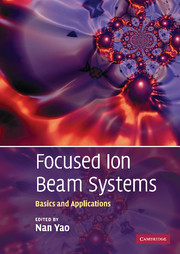Book contents
- Frontmatter
- Contents
- List of contributors
- Preface
- 1 Introduction to the focused ion beam system
- 2 Interaction of ions with matter
- 3 Gas assisted ion beam etching and deposition
- 4 Imaging using electrons and ion beams
- 5 Characterization methods using FIB/SEM DualBeam instrumentation
- 6 High-density FIB-SEM 3D nanotomography: with applications of real-time imaging during FIB milling
- 7 Fabrication of nanoscale structures using ion beams
- 8 Preparation for physico-chemical analysis
- 9 In-situ sample manipulation and imaging
- 10 Micro-machining and mask repair
- 11 Three-dimensional visualization of nanostructured materials using focused ion beam tomography
- 12 Ion beam implantation of surface layers
- 13 Applications for biological materials
- 14 Focused ion beam systems as a multifunctional tool for nanotechnology
- Index
- References
12 - Ion beam implantation of surface layers
Published online by Cambridge University Press: 12 January 2010
- Frontmatter
- Contents
- List of contributors
- Preface
- 1 Introduction to the focused ion beam system
- 2 Interaction of ions with matter
- 3 Gas assisted ion beam etching and deposition
- 4 Imaging using electrons and ion beams
- 5 Characterization methods using FIB/SEM DualBeam instrumentation
- 6 High-density FIB-SEM 3D nanotomography: with applications of real-time imaging during FIB milling
- 7 Fabrication of nanoscale structures using ion beams
- 8 Preparation for physico-chemical analysis
- 9 In-situ sample manipulation and imaging
- 10 Micro-machining and mask repair
- 11 Three-dimensional visualization of nanostructured materials using focused ion beam tomography
- 12 Ion beam implantation of surface layers
- 13 Applications for biological materials
- 14 Focused ion beam systems as a multifunctional tool for nanotechnology
- Index
- References
Summary
Introduction
Ion implantation is a method for the direct, controlled introduction of impurities into solids. In ion implantation, a beam of dopant ions is aimed at a target material (the substrate) so that the ions are incident with sufficient energy to become permanently embedded. Because ion implantation is an essentially nonequilibrium process, it allows for the creation of concentration profiles that would be impossible to achieve using equilibrium techniques such as diffusion. The advent of focused ion beam (FIB) systems spawned a host of new applications for ion implantation. The ability to create high-resolution (feature sizes of order 10 nm [1, 2]) doping configurations without the use of a mask allows not only for rapid prototyping, but also for unique devices whose fabrication would not otherwise be feasible. FIB implantation has been used to make a wide variety of experimental devices including low-dimensional transistors, single photon detectors, subwavelength optics, and quantum computers.
This chapter covers the basics of ion implantation in general and of FIB implantation in particular. Next it considers the challenge of measuring the ion dose introduced into the substrate. It then discusses the major parameters relevant to the FIB implantation process and presents a sample of their complex interrelationships. Finally, it describes the aforementioned applications of FIB implantation to the fabrication of novel devices.
Basics
In the years since its development in the 1950s [3], ion implantation has become the preferred method for the introduction of impurities into solid substrates.
- Type
- Chapter
- Information
- Focused Ion Beam SystemsBasics and Applications, pp. 318 - 336Publisher: Cambridge University PressPrint publication year: 2007



